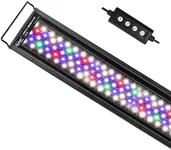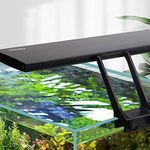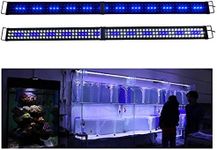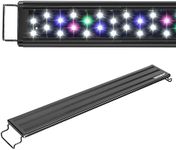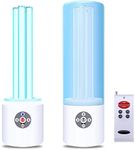Buying Guide for the Best Aquarium Light For Fishes
Choosing the right aquarium light for your fish tank is crucial for the health and well-being of your aquatic pets and plants. The right lighting not only enhances the beauty of your aquarium but also supports the biological processes of the fish and plants. When selecting an aquarium light, consider the type of fish and plants you have, the size of your tank, and the specific needs of your aquatic environment. Here are some key specifications to consider when choosing an aquarium light.Light SpectrumThe light spectrum refers to the range of light wavelengths emitted by the aquarium light. This is important because different wavelengths support different biological processes. For example, blue light promotes photosynthesis in plants, while red light can enhance the coloration of fish. Full-spectrum lights, which mimic natural sunlight, are generally the best choice for most aquariums as they support both plant growth and fish health. If you have a planted tank, look for lights that offer a good balance of blue and red wavelengths.
Light IntensityLight intensity is the amount of light produced by the aquarium light, usually measured in lumens. This is important because different types of plants and fish require different light intensities. Low-light plants and fish do well with lower intensity lights, while high-light plants need more intense lighting to thrive. For a standard fish-only tank, moderate light intensity is usually sufficient. If you have a planted tank, you may need higher intensity lighting to support plant growth. Consider the needs of your specific plants and fish when choosing the light intensity.
Light DurationLight duration refers to the amount of time the aquarium light is on each day. This is important because both fish and plants have natural day and night cycles that need to be maintained. Most aquariums require about 8-12 hours of light per day. Too much light can lead to algae growth, while too little light can hinder plant growth and affect fish behavior. Using a timer can help you maintain a consistent light schedule, which is beneficial for the overall health of your aquarium.
Light TypeThere are several types of aquarium lights, including LED, fluorescent, and incandescent. LED lights are the most popular choice due to their energy efficiency, long lifespan, and customizable light spectrum. Fluorescent lights are also a good option for planted tanks as they provide a broad spectrum of light. Incandescent lights are less common and not recommended for most aquariums due to their high heat output and lower efficiency. Choose the light type that best fits your tank's needs and your personal preferences.
Size and CoverageThe size and coverage of the aquarium light should match the size of your tank. This is important to ensure that the entire tank is evenly lit, which supports the health of all plants and fish. Measure the length of your tank and choose a light that provides adequate coverage. Some lights are adjustable or come with extendable brackets to fit different tank sizes. Make sure the light you choose can cover the entire tank to avoid dark spots and ensure even light distribution.
Water ResistanceWater resistance is a crucial feature for aquarium lights as they are constantly exposed to moisture. This is important to prevent electrical hazards and ensure the longevity of the light. Look for lights that are specifically designed for aquarium use and have a high water resistance rating. Waterproof or water-resistant lights are safer and more durable in the humid environment of an aquarium. Ensure the light you choose is rated for use in or around water to avoid any safety issues.



